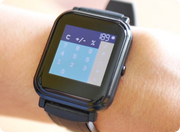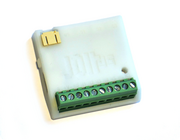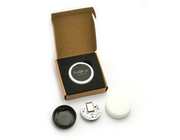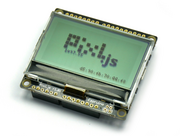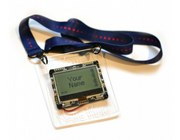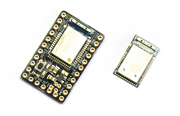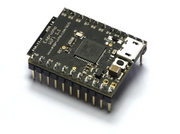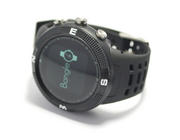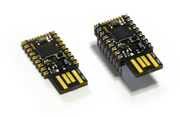Other Boards
These are other boards that Espruino compiles for, but which aren't 'officially supported'. This means:
- Espruino does not come pre-installed on the board
- Your purchase does not help to support the Espruino project
- Not all the functionality available on the Espruino Board is available on other boards
- The modules, tutorials and examples are designed for the Espruino Board and may not work
- The Web IDE may have to employ 'throttling' for error free communications - significantly slowing down your experience.
- You cannot update the firmware for other boards via the Web IDE
- We're not able to support you if you have problems using these boards. If you want support, get an official board
- The community is responsible for maintaining these boards, and as such releases are not subject to the same level of testing.
Note: ST Nucleo and Discovery boards are sold at a low price, for evaluation purposes only. According to the Evaluation products license agreement that comes with each board, you must not use them as part of a finished product. If you want to do that, please check out our official boards.
To see how to get started with the official boards, just follow our Quick Start guide, or you can Order one here.
Contents
Boards that Espruino works on
| Chip | Speed MHz |
Vars | Cost | USB | UART | SPI | Bat | Other | |
|---|---|---|---|---|---|---|---|---|---|
| Official Boards | |||||||||
| Espruino Original | STM32F104 | 72 | 2200 | £21 | Y | 3 | 2 | Y | Micro SD, Optional Bluetooth Serial, Proto area |
| Espruino Pico | STM32F401 | 84 | 5100 | £17 | Y | 3 | 2 | Y | |
| Espruino WiFi | STM32F411 | 100 | 7100 | -- | Y | 3 | 2 | N | WiFi |
| Espruino Puck.js | nRF52832 | 64 | 2200 | £25 | N | 1 | 1 | Y | Bluetooth LE, Case with Button, Accelerometer, Gyro, Magnetometer, Temperature |
| Espruino Pixl.js | nRF52832 | 64 | 2200 | £30 | N | 1 | 1 | Y | LCD Display, Arduino Headers, Bluetooth LE |
| Espruino Bangle.js | nRF52832 | 64 | 2200 | -- | N | - | - | Y | LCD Display, Bluetooth LE, Vibration, Accelerometer |
| Espruino Bangle.js 2 | nRF52840 | 64 | 12000 | £64 | N | - | - | Y | LCD Display, Bluetooth LE, Vibration, Accelerometer |
| Espruino Jolt.js | nRF52840 | 64 | 12000 | £35 | Y | 1 | 1 | Y | 8x 1A Outputs, Qwiic, LiPo Charger, Bluetooth LE |
| Espruino MDBT42Q Breakout | nRF52832 | 64 | 2200 | £17 | N | 1 | 1 | N | Bluetooth LE |
| Espruino MDBT42Q Module | nRF52832 | 64 | 2200 | £10 | N | 1 | 1 | N | Bluetooth LE, Bare Module |
| Third Party Boards | |||||||||
| Ruuvitag | nRF52832 | 64 | 2000 | $28 | N | 1 | 1 | Y | Bluetooth LE, Environment sensors |
| Seeed Wio LTE | STM32F405 | 168 | 5450 | $25 | Y | 6 | 3 | Y | Micro SD, LTE |
| Nordic Thingy:52 | nRF52832 | 64 | 2000 | $40 | N | 1 | 1 | Y | Environment & 9 Axis sensors, Mic and Speaker |
| nRF52832DK DK | nRF52832 | 64 | 2000 | $40 | N | 1 | 1 | Y | Arduino Headers |
| STM32L496GDISCOVERY | STM32L496AGI6 | 168 | 19200 | $70 | Y | 3 | 4 | N | Arduino Headers, Micro SD, Optional LTE/GSM modules |
| iTracker RAK8211 | nRF52832 | 64 | 2000 | $82 | N | 1 | 1 | Y | GPS, GPRS, LTE or NB-IoT |
| iTracker RAK8212 | nRF52832 | 64 | 2000 | $88 | N | 1 | 1 | Y | GPS, GPRS, LTE, NB-IoT |
| Other Boards | |||||||||
| STM32VLDISCOVERY | STM32F100 | 24 | 250 | €12 | N | 3 | 2 | N | |
| STM32F3DISCOVERY | STM32F303 | 72 | 2800 | €14 | Y | 3 | 2 | N | |
| STM32F4DISCOVERY | STM32F407 | 168 | 5000 | €16 | Y | 6 | 3 | N | |
| ST NUCLEO-F401RE | STM32F401 | 84 | 5300 | €12 | N | 3 | 4 | N | Arduino Headers |
| ST NUCLEO-F411RE | STM32F411 | 84 | 5300 | €12 | N | 3 | 4 | N | Arduino Headers |
| OLIMEXINO-STM32 | STM32F103RB | 72 | 700 | €20 | Y | 3 | 2 | LiPo | Arduino Headers, Micro SD |
| LeafLabs Maple RBT6 | STM32F103RB | 72 | 700 | €40 | Y | 3 | 2 | LiPo | Arduino Headers |
| 'HY' 2.4" LCD | STM32F103VE | 72 | 2800 | €30 | Y | 3 | 2 | N | SD Card, LCD Display |
| 'HY' 2.8" LCD | STM32F103RB | 72 | 700 | €30 | Y | 3 | 2 | N | SD Card (unsupported),LCD Display |
| 'HY' 3.2" LCD | STM32F103VC | 72 | 2000 | €30 | Y | 3 | 2 | N | SD Card, LCD Display |
| micro:bit | nRF51822 | 16 | 200 | - | Y | 1 | 1 | Y | Bluetooth LE, LED matrix |
| micro:bit 2 | nRF52833 | 64 | 6000 | - | Y | 1 | 1 | Y | Bluetooth LE, LED matrix, Speaker, Mic |
| ESP8266 | Xtensa | 80 | 1023 | €10 | N | 1 | 1 | N | WiFi |
| ESP32 | Xtensa | 240 | 5000 | $10 | N | 2 | 2 | N | Bluetooth LE, Flash FS, WiFi |
Key: Y=Yes, N=No
Note: Third party boards are designed, sold and supported by companies who help to support Espruino's continued development. They may or may not come with Espruino pre-installed, however we ensure that up to date firmware for these boards is available so you always have access to the newest features.
You can also see these boards listed with thumbnails at the top of the reference page.
After you've got a board, head to the Download page and then follow the instructions below in order to flash your board.
MORE INFORMATION
OLIMEXINO-STM32
Good value, and can usually be purchased from well-known suppliers. It contains an SD card, Arduino-style headers, and conveniently a LiPo battery connector (with charger).
It comes pre-flashed with a bootloader. HOWEVER there is not enough space for this and Espruino, so you will need to overwrite it using a USB-TTL converter. See Serial Bootloader for instructions.
You can get this directly from Olimex or Farnell/Element14.
'HY' LCD Modules
These appear to come from Haoyu electronics and come in a few types, with varying LCD sizes. They are amazingly good value, and can be obtained from eBay (although they are often shipped direct from Hong Kong or China). They don't generally have a specific name or model number, so are hard to tell apart.
Espruino contains bitmap and vector fonts, and along with the SD card driver and space for saving variables Espruino starts to have trouble fitting in just 128kb of Flash - so we suggest that you avoid the RBT6-based board and head for the VET6 or VCT6 ones.
2.4" STM32F103VET6 - 512kb Flash, 64kb RAM - The largest board, but with the most features - 4 buttons, 4 LEDs, 2 Potentiometers, 2x USB, an RS232-level serial connection, SD card, buzzer, and a external flash chip. Has 'HY-STM32_100P' on the back of the PCB. BEWARE: There is a new version of this board that is wired up differently - Espruino will only drive the LCD on the original board.
2.8" STM32F103VET6 - 256kb Flash, 48kb RAM - This looks just like the 2.4" STM32F103VET6, but is UNTESTED (May work with 2.4" drivers)
2.8" STM32F103RBT6 - 128kb Flash, 20kb RAM - This works, however the board itself very basic with few peripherals, the CPU does not have much flash memory, and it is not recommended. RBT6 does not support the faster FSMC LCD interface, so LCD updates are slow. SD card is currently unimplemented. Has MINI-STM32-V3.0 on the main board under the LCD. BEWARE: Boards with an SD card and 'armjishu.com' written on the bottom are currently unsupported.
3.2" STM32F103VCT6 - 256kb Flash, 48kb RAM - Works well. It has a big display and it is quite fast. Few on-board peripherals though (2 LEDs, 2 Buttons and an SD card). Recommended.
3.2" STM32F103RBT6 - 128kb Flash, 20kb RAM - UNTESTED (May work with 2.8" drivers)
Wiring up a serial port
Every supported board except the STM32VLDISCOVERY has a USB serial port, so most users can skip this step. If you have an STM32VLDISCOVERY, or you want to use Bluetooth, or to connect to a Raspberry Pi using serial (rather than USB), please see the Wiring Up page.
Plug in Espruino
You communicate with Espruino using a Terminal Emulator over a Serial port. Most Espruino devices can emulate a Serial port over USB, so when you plug these in to your PC or Mac the Operating System will automatically detect them. All you need to do is find out what the Operating System has 'called' the serial port that has been created.
Windows XP Users: Windows XP seems not to have generic drivers for USB Virtual COM Ports installed, so you'll have to get them from ST via this link (thanks Josef!)
First off, you need to know which USB port to connect to:
| ESPRUINO & PICO BOARDS | There's just one USB port - so it's easy! |
| NUCLEOF4xxRE | There's just one USB port, which serves as the programmer, serial port, and mass storage device. |
| STM32VLDISCOVERY | You will have had to use a USB-TTL converter (see Wiring Up). After programming you'll need to connect at 9600 baud. |
| STM32F3DISCOVERY | Plug in to the port labelled 'USB USER'. Note: This board is more difficult to connect to. You need to power up the board without 'USB USER' plugged in, and then plug in USB later. If you subsequently reset the board, you'll need to unplug USB and plug it back in. |
| STM32F4DISCOVERY | Plug in to the port nearest the headphone Jack. Note: This board still needs power from an external source such as the USB port on the other side. |
| 'HY' board | Use either of the two available USB ports. The one nearest the power LED is a built-in USB-TTL converter, and the other is a Virtual COM port. Note: We'd suggest using the 'Virtual COM port' USB port as this is faster and shouldn't have flow control problems. |
| Olimexino STM32 Leaflabs Maple | The one USB port |
Don't plug the device in right away though.
Flashing Espruino
Espruino Board
See the Download page for more information - the Web IDE directly supports updating firmware on these boards.
ST NUCLEO-F4xxRE
When you plug your board in, it should appear as a USB flash drive.
To actually communicate with Espruino you'll need access to the communications port on the Nucleo, and for that you may need some drivers. ST provides them for Windows Vista/7/8 and XP. You may also want to check out ST's getting started guide.
If this is the first time you've used the board then you will probably want to update your Nucleo's firmware. Not doing this could cause problems when you try and upload Espruino (or any software) - especially on Macs.
Copy the file espruino_1vXX_nucleof401re.bin out of the ZIP file you got from the download page and paste it into the flash drive
Wait until the LEDs have stopped blinking, reset your board, and connect with the Web IDE (at 9600 baud, the default) to start using Espruino.
STM32 (VL/F3/F4) Discovery
On Windows
Go to the ST-Link website: http://www.st.com/internet/evalboard/product/251168.jsp and click 'Design Support', then download and install the 'STM32 ST-LINK utility'.
Extract the archive containing Espruino
Run the 'STM32 ST-LINK Utility'
Click 'Target'->'Erase Chip'
Click 'File'->'Open File' and choose espruino_1vXX_stm32vldiscovery.bin
When asked if you want to program, click 'Yes'
Click 'Program' on the next window
On Linux/Mac
On Linux: Download and install 'stlink' using the instructions here:https://github.com/texane/stlink/blob/master/README
On Mac: Download and install 'stlink', either by typing:
brew install libusb
git clone https://github.com/texane/stlink.git
cd stlink
LIBRARY_PATH=/usr/local/lib
C_INCLUDE_PATH=/usr/local/include
./autogen.sh
./configure
make
Or by using the instructions here: [http://cu.rious.org/make/getting-stlink-to-work-on-mac-os-x-with-macports/](http://cu.rious.org/make/getting-stlink-to-work-on-mac-os-x-with-macports/) however Branton tells us that these are out of date.
Extract the archive containing Espruino to the stlink directory.
Go to the stlink directory, and type: 'flash/st-flash write espruino_1vXX_stm32vldiscovery.bin 0x08000000' (be sure to change the filename to the correct one for your device)
Olimexino-STM32 AND LeafLabs Maple
Unfortunately the USB bootloader pre-installed on these devices takes up too much flash to allow a usable version of Espruino to be installed. This means you'll have to overwrite the USB bootloader. This is pretty simple - you just need a USB-TTL converter. It's also trivial to write the bootloader back in later on.
Just follow our Serial Bootloader instructions and use the file espruino_1vXX_olimexino_stm32.bin. If you want to restore your board to use the Maple bootloader, just use the binary file available from http://leaflabs.com/docs/bootloader.html#flashing-a-custom-bootloader
'HY' LCD Boards
The 'HY' boards have a USB-RS232 converter onboard, so to flash them, you can use the STM32's built-in bootloader:
- Make sure you don't still have a terminal application running
- Set BOOT0 to 1:
- On 2.4" boards, there is a 'BOOT0' jumper
- On other boards, BOOT0 is a button which you must hold down while you tap the RESET button
- Plug USB into the RS232 converter port of the board. Note that Prolific has decided not to provide drivers for older versions of their PL2303 chips on Windows 7 and later, so on some boards that use this chip, you may have problems.
- On 2.4" board this is the bottom connector (near the power LED)
- On other boards, with the buttons at the bottom of the board, this is the connector on the top left
- Follow our Serial Bootloader instructions - use the file
espruino_..._hystm32_XX_YY.binwhere XX is the size of the LCD screen (24=2.4, etc) and YY is the two letters from the chip name after F103 (STM32F103VCT6 = VC) - On the 2.4" board, move the 'BOOT0' jumper back to 0
- Press Reset, and Espruino will load.
- If connecting to the RS232 converter port of the board, you'll need to connect at 9600 baud.
In order to run the Python file from the link above, you may need to have Python 2.7 installed, and not the newest version of Python (version 3).
Raspberry Pi
The version for Raspberry Pi is a simple executable. Extract it from the ZIP file and make it executable with:
chmod a+x espruino_1vXX_raspberrypi
You may also want to rename it:
mv espruino_1vXX_raspberrypi espruino
Finally, just run it with:
./espruino
Note that in order to use GPIO (or to start an HTTP server with a port number less than 1024), Espruino will need to be run as root:
sudo ./espruino
Also, the Raspberry Pi version doesn't currently support Serial, SPI, OneWire or I2C - which means you're stuck with GPIO.
Finally...
Please Note: If you have saved code to Espruino, when booting it will load your saved JavaScript program from flash memory. Occasionally we change the way programs are stored in memory between versions in order to make Espruino more efficient, and when this happens, after flashing the latest version of Espruino to the device, it may stop booting. You can solve this in two ways:- If you're using the stm32loader.py, you can supply the '-e' flag to completely erase the STM32's flash.
- Hold down Button1 while booting (which will stop Espruino automatically loading the saved program) - see here for details. You can then type 'save()' to save a correct (but Empty) JavaScript program back into flash.
See our Quick Start page for how to get started using Espruino itself.
ESP8266
Please see the ESP8266 page for more information.
BBC Micro:bit
Please see the Micro:bit page for more information.
ESP32
Please see the ESP32 page for more information.
Third Party Boards
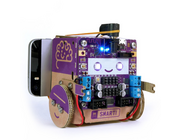 Smartibot
Smartibot
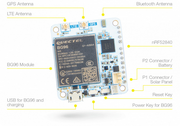 iTracker RAK5010
iTracker RAK5010
 Seeed Wio LTE
Seeed Wio LTE
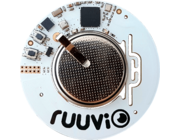 Ruuvitag
Ruuvitag
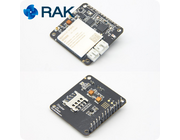 iTracker RAK8212
iTracker RAK8212
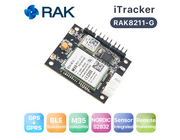 iTracker RAK8211 (G/NB)
iTracker RAK8211 (G/NB)
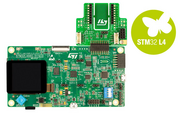 STM32L496G Discovery Board
STM32L496G Discovery Board
Official Espruino Boards
This page is auto-generated from GitHub. If you see any mistakes or have suggestions, please let us know.
